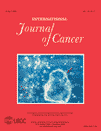Proximity of first intercourse to menarche and the risk of human papillomavirus infection: A longitudinal study
Abstract
Cross-sectional studies have suggested that compared with women who delay the start of their sexual career, those who first have intercourse soon after menarche are more susceptible to cervical human papillomavirus (HPV) infection and thus have a greater risk of cervical neoplasia. We describe, using longitudinal observations, how the risk of infection with HPV varies with the interval between menarche and first intercourse in 474 women aged 15–19 recruited within 12 months of first intercourse and before the acquisition of a second sexual partner. One hundred forty-five women became HPV-positive; the cumulative risk of HPV infection 3 years after first intercourse was 45.0% (95% CI = 37.9–51.2). In univariate analyses, the hazards ratio (HR) of HPV infection increased significantly with age at first intercourse (HR = 1.212 per year; 95% CI = 1.050–1.398), partner age (HR = 1.084 per year; 95% CI = 1.045–1.125) and when women reported a sexually experienced partner (HR = 2.794; 95% CI = 1.804–4.326); the interval between menarche and first intercourse was a significant predictor of infection, with an increase in the HR of 12.9% for every year of increase in this interval (95% CI = 2.1%–24.9%). In a multivariate analysis, compared with women who first had intercourse within 3 years of menarche, those who postponed first intercourse beyond this time had a greater risk of infection (HR = 1.581; 95% CI = 1.113–2.245) after controlling for age and sexual experience of partner. © 2004 Wiley-Liss, Inc.




